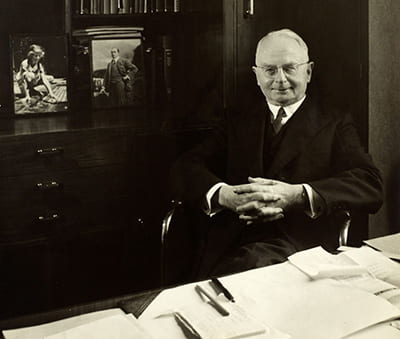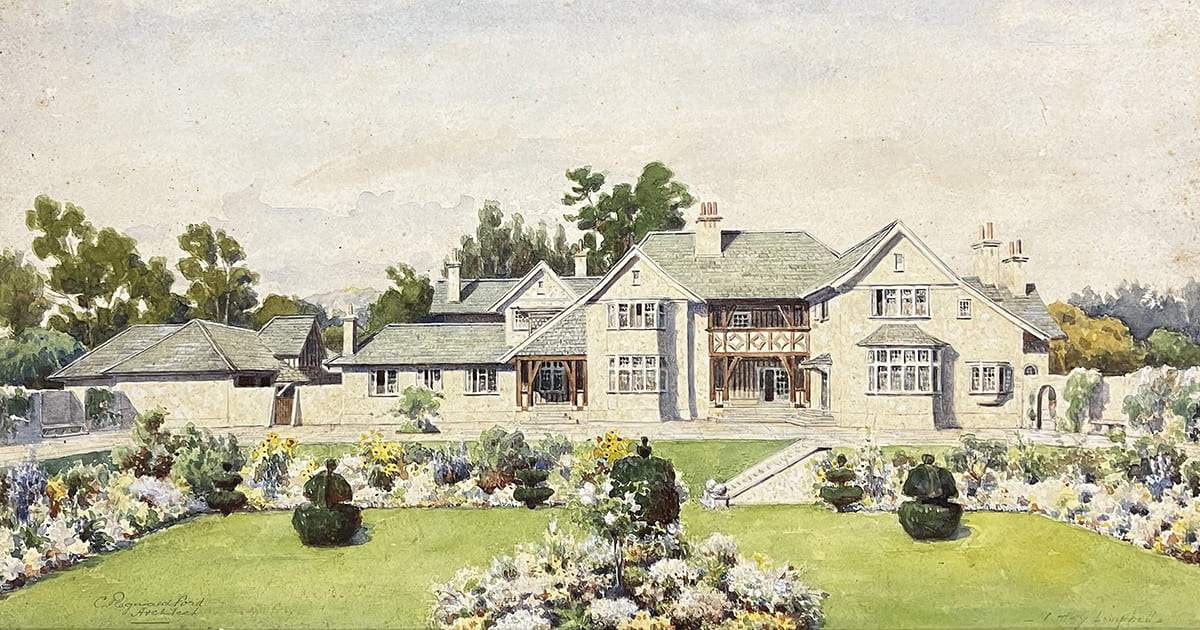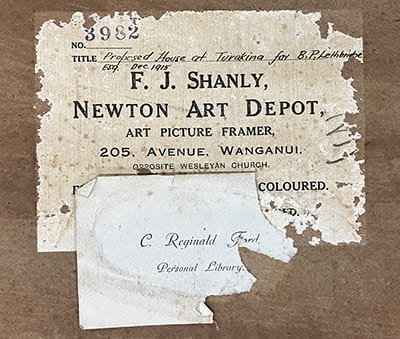To mark this year’s 20th anniversary of Special Collections, the curators have selected some intriguing items for the Twenty at 20 series. Here is number 15.
Envisaging architecture in watercolour
Architect C. Reginald Ford is probably best known for the major public buildings he completed in partnership with W. H. Gummer, such as the Auckland Railway Station and the National Art Gallery in Wellington.
However, his early architectural career was dominated by domestic projects such as the one depicted in this watercolour labelled “Proposed house at Turakina for B. P. Lethbridge Esq. Dec 1915”.1 It dates from shortly after he moved to Whanganui, before his brief partnership with Robert Talboys and eight years before the formation of his almost 40-year partnership with Gummer.2
Floriferous garden borders and a sunken lawn studded with topiary complement the large country house and associated outbuildings. The idyllic scene painted by Charles Hay-Campbell was intended to sell Ford’s design to potential client Bennett Perry Lethbridge for his extensive rural property at Turakina, southeast of Whanganui. It was not uncommon for architects to employ specialists to produce presentation perspective drawings of their designs, often in watercolour, to evoke the finished project for important clients. Both men have signed the watercolour, with Ford clearly noted as the architect. Hay-Campbell, a British-trained artist, emigrated to New Zealand in 1915 and taught art at Whanganui Collegiate.3
Never realised
Sadly it seems the house was never built for Lethbridge. When he died in 1929, he was still living in ‘Annbank’, a two-storey wooden homestead at Turakina which he had inherited from his father George. Bennett Lethbridge and his property are probably best remembered as the benefactor and location of the first children’s health camps in New Zealand.4
Ford retained the watercolour for his personal library and later gifted it to a colleague at Gummer and Ford. In 2018, the colleague’s widow donated it to the University and it was reunited with other items in Special Collections that had once belonged to Ford. This includes several books that he may have referred to when designing the house for Lethbridge. The elongated asymmetrical rooflines and timber detailing on the verandah and entrance portico echo some of the designs seen in his copies of Small country houses of to-day (1911) and Houses and gardens (1913).
Multi-faceted man

Portrait of Reginald Ford, Auckland Libraries Heritage Collections 34-0147, photographer Clifton Firth.
Ford (1880-1972) was a man with diverse interests and talents. In addition to writing about architectural topics, including one of the first books in English on earthquakes and building construction, he also wrote about his travels to Antarctica as Scott’s assistant on the Discovery expedition (1901-04) and about English porcelain and pottery for the Auckland Institute and Museum where he acted as an honorary curator.5
While the house for Lethbridge at Turakina was not realised Ford became one of the most prominent architects of his time in the country. Our collection contains many examples of his success.
Discover more
- The watercolour will be displayed outside Special Collections, General Library, Level G, until 10 November. To view the item in the Reading Room after that date, please contact us.
- Search the Architecture Archive for architectural drawings by Gummer and Ford.
- Find the published items in the collection written by, about, or owned by Ford.
- Read a biography of Ford.
Sarah Cox, Special Collections
References
1. C. Reginald Ford proposed house at Turakina for B. P. Lethbridge Esq. MSS & Archives Arch 2022/02. Special Collections, Te Tumu Herenga Libraries and Learning Services.
2. Lowe. P. (1998) ‘Ford, Charles Reginald’, Dictionary of New Zealand Biography.
3. National Library of New Zealand (n.d.) Hay-Campbell, Charles Duncan, 1867-1936.
4. Children’s health camp. (1919, November 21) Wanganui Chronicle, page 5; Loss to district. (1938, August 5) Wanganui Chronicle, page 8.
5. Lowe. P. (1998) ‘Ford, Charles Reginald’, Dictionary of New Zealand Biography.
Feature image: “Proposed house at Turakina for B. P. Lethbridge Esq. Dec 1915” designed by C. R. Ford.
Image 2: Labels on the back of the watercolour.
Image 3: Portrait of Reginald Ford, Auckland Libraries Heritage Collections 34-0147, photographer Clifton Firth.


